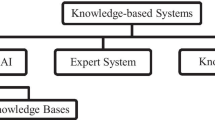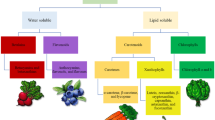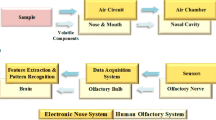Abstract
This study employed electronic nose (E-nose) to detect tea plants with different types of damage (undamaged, mechanically damaged, damages caused by Ectropis obliqua and Ectropis grisescens). Gas chromatography–mass spectrometry was employed as an auxiliary technique for proving the potential of E-nose detection. A new feature extraction method was applied for obtaining comprehensive features of E-nose dataset. Feature selection method based on principal component analysis (PCA) was applied for further feature selection. Four dimensionality reduction methods [PCA, locality preserving projections (LPP), kernel principal component analysis and locally linear embedding] and three classification algorithms [multilayer perceptron neural network, extreme learning machine and support vector machine (SVM)] were employed, and the best combination of dimensionality reduction method and classification algorithm was determined. The results showed that the combination of LPP and SVM was the best, and its correct discrimination rate was as high as 100%, which proved the advantage of the new signal processing method and the feasibility of E-nose in discriminating among tea plants with different types of damage.



Similar content being viewed by others
References
Abdi H, Williams LJ (2010) Principal component analysis. Wiley Interdiscip Rev Comput Stat 2(4):433–459
Ahmad AS, Hassan MY, Abdullah MP, Rahman HA, Hussin F, Abdullah H, Saidur R (2014) A review on applications of ANN and SVM for building electrical energy consumption forecasting. Renew Sust Energ Rev 33(2):102–109
Andrews SJ, Hackenberg SC, Carpenter LJ (2015) Technical note: a fully automated purge and trap GC–MS system for quantification of volatile organic compound (VOC) fluxes between the ocean and atmosphere. Ocean Sci 11(2):313–321
Baietto M, Wilson AD (2015) Electronic-nose applications for fruit identification, ripeness and quality grading. Sensors 15(1):899–931
Cai XM, Sun XL, Dong WX, Wang GC, Chen ZM (2014) Herbivore species, infestation time, and herbivore density affect induced volatiles in tea plants. Chemoecology 24(1):1–14
Degenhardt DC, Greene JK, Khalilian A (2012) Temporal dynamics and electronic nose detection of stink bug-induced volatile emissions from cotton bolls. Psyche A J Entomol 2012(2):340–345
Hartyáni P, Dalmadi I, Knorr D (2013) Electronic nose investigation of Alicyclobacillus acidoterrestris inoculated apple and orange juice treated by high hydrostatic pressure. Food Control 32(1):262–269
Hazarika LK, Bhuyan M, Hazarika BN (2009) Insect pests of tea and their management. Annu Rev Entomol 54(1):267–284
He Q, Jin X, Du C, Zhuang F, Shi Z (2014) Clustering in extreme learning machine feature space. Neurocomputing 128(5):88–95
Holopainen JK, Gershenzon J (2010) Multiple stress factors and the emission of plant VOCs. Trends Plant Sci 15(3):176–184
Huang GB, Zhou H, Ding X, Zhang R (2012) Extreme learning machine for regression and multiclass classification. IEEE Trans Syst Man Cybern B (Cybern) 42:513–529
Lorenzo AD, Nabavi SF, Sureda A, Moghaddam AH, Khanjani S, Arcidiaco P, Nabavi SM, Daglia M (2016) Antidepressive-like effects and antioxidant activity of green tea and gaba green tea in a mouse model of post-stroke depression. Mol Nutri Food Res 60(3):566–579
Ma T, Xiao Q, Yu YG, Wang C, Zhu CQ, Sun ZH, Chen XY, Wen XJ (2016) Analysis of tea geometrid (Ectropis grisescens) pheromone gland extracts using GCEAD and GC × GC/TOFMS. J Agric Food Chem 64(16):3161–3166
Mei C, Yang M, Shu D, Jiang H, Liu G (2015) Monitoring the wheat straw fermentation process using an electronic nose with pattern recognition methods. Anal Method 7(14):6006–6011
Moraes R, Valiati JF, Neto WPG (2013) Document-level sentiment classification: an empirical comparison between SVM and ANN. Expert Syst Appl 40(2):621–633
Musa AB (2014) A comparison of ℓ1-regularizion, PCA, KPCA and ICA for dimensionality reduction in logistic regression. Int J Mach Learn Cybern 5(6):861–873
Orhan U, Hekim M, Ozer M (2011) EEG signals classification using the K-means clustering and a multilayer perceptron neural network model. Expert Syst Appl 38(10):13475–13481
Ramya M, Ponmurugan P, Saravanan D (2013) Management of Cephaleuros parasiticaus Karst (Trentepohliales: Trentepohliaceae), an algal pathogen of tea plant, Camellia sinsensis (L.) (O. Kuntze). Crop Protect 44:66–74
Roweis ST, Saul LK (2000) Nonlinear dimensionality reduction by locally linear embedding. Science 290(5000):2323–2326
Saravanakumar D, Vijayakumar C, Kumar N, Samiyappan R (2007) PGPR-induced defense responses in the tea plant against blister blight disease. Crop Protect 26(4):556–565
Scott SM, James D, Ali Z (2006) Data analysis for electronic nose systems. Microchim Acta 156(3–4):183–207
Singh P, Yadava RDS (2013) Enhancing chemical identification efficiency by SAW sensor transients through a data enrichment and information fusion strategy-a simulation study. Meas Sci Technol 24(5):150–158
Snoeren TA, De Jong PW, Dicke M (2007) Ecogenomic approach to the role of herbivore-induced plant volatiles in community ecology. J Ecol 95(1):17–26
Timsorn K, Thoopboochagorn T, Lertwattanasakul N, Wongchoosuk C (2016) Evaluation of bacterial population on chicken meats using a briefcase electronic nose. Biosyst Eng 151:116–125
Übeylı ED, Güler I (2004) Multilayer perceptron neural networks to compute quasistatic parameters of asymmetric coplanar waveguides. Neurocomputing 62(1):349–365
Vernarelli JA, Lambert JD (2013) Tea consumption is inversely associated with weight status and other markers for metabolic syndrome in US adults. Eur J Nutr 52(3):1039–1048
Wang D, Li CF, Ma CL, Chen L (2015a) Novel insights into the molecular mechanisms underlying the resistance of Camellia sinensis to Ectropis obliqua provided by strategic transcriptomic comparisons. Sci Hortic 192:429–440
Wang J, Gao D, Wang Z (2015b) Quality-grade evaluation of petroleum waxes using an electronic nose with a TGS gas sensor array. Meas Sci Technol 26(8):085004/1–085004/6
Xu Y, Feng G, Zhao Y (2009) One improvement to two-dimensional locality preserving projection method for use with face recognition. Neurocomputing 73(1):245–249
Yan J, Guo X, Duan S, Jia P, Wang L, Peng C, Zhang S (2015) Electronic nose feature extraction methods: a review. Sensors 15(11):27804–27831
Yen GC, Chen HY (1995) Antioxidant activity of various tea extracts in relation to their antimutagenicity. J Agric Food Chem 43(1):27–32
Zhang D, Shi X, Sheng Y (2015) Comprehensive measurement of energy market integration in East Asia: an application of dynamic principal component analysis. Energy Econ 52:299–305
Zhou B, Wang J (2011) Discrimination of different types damage of rice plants by electronic nose. Biosyst Eng 109(4):250–257
Acknowledgements
The authors acknowledge the financial support of the Chinese National Foundation of Nature and Science through Projects 31370555 and 31670654.
Author information
Authors and Affiliations
Corresponding author
Ethics declarations
Conflict of interest
All authors declare that they have no conflict of interest.
Ethical approval
This article does not contain any studies requiring ethical approval.
Rights and permissions
About this article
Cite this article
Sun, Y., Wang, J., Sun, L. et al. Evaluation of E-nose data analyses for discrimination of tea plants with different damage types. J Plant Dis Prot 126, 29–38 (2019). https://doi.org/10.1007/s41348-018-0193-1
Received:
Accepted:
Published:
Issue Date:
DOI: https://doi.org/10.1007/s41348-018-0193-1




